In trepidation of my first viewing on TV of Psycho, I hid in the kitchen for the key moment of the shower scene. Cowardy custard.
Audiences of 1960 were not so fortunate.
In all his six decades of filmmaking, and for what in most of that time has generally been considered his masterwork portfolio of cinematic craft, Alfred Hitchcock is best remembered for this shocker - one of his cheaper efforts - but how rightly so. Psycho is probably not nowadays the most terrifying film ever made - time and the outside world have hardened people's resolve so much - but it still has the most terrifying music score.
From the time of the credits to the time of the shower scene, that score by Bernard Herrmann is always brimming away in the background, making you aware, particularly during the long car journey, that something is going to happen at the end of this...
It must have been bizarre to be asked to come and see a film which could only be watched from the beginning or not at all - this in the days when roving film shows allowed paying audiences to enter the cinema whenever they liked, hence the expression "this is where we came in". Added to that, there is the added tease of a plot involving stolen money from a Texas office, rashly entrusted into the hands of feisty Marion Crane (Janet Leigh), who could use that $40,000 very nicely thank you, for her potential nuptials with illicit boyfriend Sam Loomis (John Gavin).
Guilt-ridden along the long drive out of Arizona however, an almost judgmental shower (ah, the metaphor is appropriate) falls down and she takes refuge at an out-of-the-way hostel called The Bates Motel. After a little friendly talk with the young and slightly repressed owner's son Norman, Marion decides to take back the $40,000, and then have a shower...
For whatever reason - perhaps because it was deemed too shocking even for Hitchcock - the responsibility for directing the shower scene has sometimes been credited to Saul Bass. It brings into question who actually is the maker of a film? Bass's storyboards (together with his nifty title sequences that were his stock-in-trade) were used by Hitch as the blueprint for all the murder scenes, and Hitch, grateful for Bass's visual input, invited Bass onto the set (right) and gave him the generous credit "Pictorial Consultant" that started the whole controversy over 'directing' the shower scene.
As great as the shock of a vicious murder taking place before our very (perceived) eyes, is the still unparallelled shock in movie history of a story losing its central character, as well as the sub-plot that goes with her too (although the credits drop the hint with the "and Janet Leigh" at the beginning).
From that moment on, you feel anything could happen. Once the situation is set up, and the rules of storytelling defiantly broken, the Master draws you in.
A particular fine example of his craft is the long staircase tracking shot, following the mysterious Norman as he chats with Mother and drags her down to the basement, Hitch teasing the audience but knowing that they, like he, don't want to get too close to this strange family. It is the quintessential suspense of the slightly open door.
Far more shocking for me, on reflection, than the stabbing of Marion is the horrific death of the intrepid investigator Arbogast (Martin Balsam), thus breaking another rule of story telling: you don't kill off your detective before he's finished detecting! Balsam is the figure of integrity, the one who's going to sort things out for us. It was also a death that, unlike Marion's, I wasn't expecting. Once he's gone, you don't really envy anyone who tries to go into that house.
How could Hitch have known what it would lead to? A whole spate of slasher shockers in the decades to come, including three deteriorating sequels, and most curious of all, a 1999 Gus Van Sant remake using exactly the same script, a curious case of cinematic plagiarism (or as Van Sant put, his "cover version" of a classic), whose lack of success proved that you cannot make a film any better than that already made by a master filmmaker.
One figure at the end, however, leaves audiences in no doubt that this is far from a laughing matter: that final creepy shot of Anthony Perkins is still difficult to watch without severe trepidation - even more than the shower scene - when that last sinister face reveals itself at the end of the film.
I experienced (there's no better word for it) Psycho in the cinema for the first time at long last, at the Prince Charles Cinema on a Halloween horror themed weekend (time had sanitized the horror down from X certificate to 15), of which the greatest impression felt was the sound: significantly higher on the soundtrack than usual, with Herrmann's score screeching out. Come the time of the shower scene, I was less afraid of being scared than of being deafened. At least then I was able to get some idea of what original audiences of the time went through.






No comments:
Post a Comment